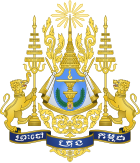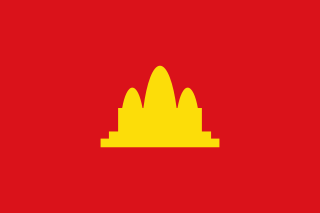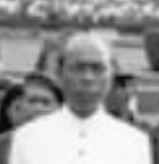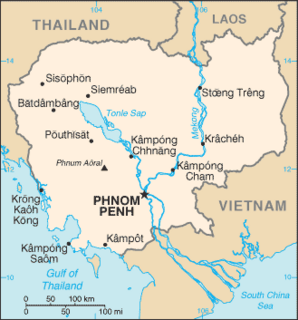 |
|---|
| |
A referendum on suspending the provincial parliaments was held in Cambodia on 29 November 1959. [1]
 |
|---|
| |
A referendum on suspending the provincial parliaments was held in Cambodia on 29 November 1959. [1]
On 6 October, the government of Cambodia called for a referendum to decide who would hold power between the government and the Khmer Serei, which was led by Sam Sary and Son Ngoc Thanh. Norodom Sihanouk asserted that if he lost he would either agree to a trial or to go into exile, but that if he won the other leaders would be named outlaws. [2]
| Choice | Votes | % |
|---|---|---|
| For | 99.95 | |
| Against | 0.05 | |
| Invalid/blank votes | – | |
| Total | 100 | |
| Source: International Republican Institute [1] | ||
The changes adopted in suspending the provincial legislatures would last beyond Sihanouk's abdication in 1970. [1]

The politics of Cambodia are defined within the framework of a constitutional monarchy, in which the king serves as the head of state, and the prime minister is the head of government. The collapse of communism set in motion events that led to the withdrawal of the Vietnamese armed forces, which had established their presence in the country since the fall of the Khmer Rouge. The 1993 constitution, which is currently in force, was promulgated as a result of the 1991 Paris Peace Agreements, followed by elections organized under the aegis of the United Nations Transitional Authority in Cambodia. The constitution declares Cambodia to be an "independent, sovereign, peaceful, permanently neutral and non-aligned country." The constitution also proclaims a liberal, multiparty democracy in which powers are devolved to the executive, the judiciary and the legislature. However, there is no effective opposition to the Prime Minister Hun Sen, who has been in power since 1985. His Cambodian People's Party won all 125 seats in the National Assembly in 2018 after the banning of opposition party CNRP and KNLF. KNLF became a main opposition exiled in Denmark after CNRP was dissolved. Even if the communal election which will be in 2022 and national 2023, there is no international observers such as EU or UN. The government is considered to be autocratic.

Pol Pot was a Cambodian revolutionary, dictator, and politician who ruled Cambodia as Prime Minister of Democratic Kampuchea between 1976 and 1979. Ideologically a Marxist–Leninist and a Khmer nationalist, he was a leading member of Cambodia's communist movement, the Khmer Rouge, from 1963 until 1997 and served as the General Secretary of the Communist Party of Kampuchea from 1963 to 1981. Under his administration, Cambodia was converted into a one-party communist state and perpetrated the Cambodian genocide.

Marshal Lon Nol was a Cambodian politician and general who served as Prime Minister of Cambodia twice, as well as serving repeatedly as defence minister and provincial governor. As a nationalist and conservative, he led the military coup of 1970 against Prince Norodom Sihanouk, abolished the monarchy, and established the short-lived Khmer Republic. Constitutionally a semi-presidential republic, Cambodia was de facto governed under a military dictatorship. He was the commander-in-chief of the Khmer National Armed Forces during the Cambodian Civil War. On April 1st, 1975, 16 days before the Khmer Rouge captured Phnom Penh, Lon Nol fled to the United States, first to Hawaii and Michigan and then to California, where he remained until his death in 1985.

Norodom Sihanouk was a Cambodian statesman, Sangkum and FUNCINPEC politician, film director, and composer who led Cambodia in various capacities throughout his long career, most often as both King and Prime Minister of Cambodia. In Cambodia, he is known as Samdech Euv. During his lifetime, Cambodia was under various regimes, from French colonial rule, an independent kingdom (1953–1970), a republic (1970–1975), the Khmer Rouge regime (1975–1979), another communist regime (1979–1989), a state (1989–1993) to finally another kingdom.

The Khmer Republic was a pro-United States military-led republican government of Cambodia that was formally declared on 9 October 1970. The Khmer Republic was politically headed by Prime Minister Lon Nol and Prince Sisowath Sirik Matak who took power in the 18 March 1970 coup against Prince Norodom Sihanouk.

The French protectorate of Cambodia refers to the Kingdom of Cambodia when it was a French protectorate within French Indochina, a collection of Southeast Asian protectorates within the French Colonial Empire. The protectorate was established in 1863 when the Cambodian King Norodom requested the establishment of a French protectorate over his country, meanwhile Siam renounced suzerainty over Cambodia and officially recognised the French protectorate on Cambodia.

The Kingdom of Cambodia, also known as the First Kingdom of Cambodia, and commonly referred to as the Sangkum period, refers to Norodom Sihanouk's first administration of Cambodia from 1953 to 1970, an especially significant time in the country's history. Sihanouk continues to be one of the most controversial figures in Southeast Asia's turbulent and often tragic postwar history. From 1955 until 1970, Sihanouk's Sangkum was the sole legal party in Cambodia.

The Cambodian Civil War was a civil war in Cambodia fought between the forces of the Communist Party of Kampuchea against the government forces of the Kingdom of Cambodia and, after October 1970, the Khmer Republic, which had succeeded the kingdom.

Khieu Samphan is a Cambodian former communist politician and economist who was the chairman of the state presidium of Democratic Kampuchea (Cambodia) from 1976 until 1979. As such, he served as Cambodia's head of state and was one of the most powerful officials in the Khmer Rouge movement, although Pol Pot remained the General Secretary in the party.

Sisowath Sirik Matak was a Cambodian politician and member of the Cambodian royal family, under the House of Sisowath.
The 1970 Cambodian coup d'état was the removal of the Cambodian Chief of State, Prince Norodom Sihanouk, after a vote in the National Assembly on 18 March 1970. Emergency powers were subsequently invoked by the Prime Minister Lon Nol, who became effective head of state, and led ultimately to the removal of Queen Sisowath Kossamak and the proclamation of the Khmer Republic later that year. It is generally seen as a turning point in the Cambodian Civil War. No longer a monarchy, Cambodia was semi-officially called "État du Cambodge" in the intervening six months after the coup, until the republic was proclaimed.

The Coalition Government of Democratic Kampuchea, renamed in 1990 to the National Government of Cambodia, was a coalition government in exile composed of three Cambodian political factions, namely Prince Norodom Sihanouk's FUNCINPEC party, the Party of Democratic Kampuchea and the Khmer People's National Liberation Front (KPNLF) formed in 1982, broadening the de facto deposed Democratic Kampuchea regime. For most of its existence, it was the internationally recognized government of Cambodia.

In Tam was a Cambodian politician who once served as the prime minister of the Khmer Republic. He served in that position from 6 May 1973 to 9 December 1973, and had a long career in Cambodian politics.

Sơn Ngọc Thành was a Cambodian nationalist and republican politician, with a long history as a rebel and a government minister.

The Sihanouk Trail was a logistical supply system in Cambodia used by the People's Army of Vietnam (PAVN) and its Viet Cong (VC) guerillas during the Vietnam War (1960–1975). Between 1966 and 1970, this system operated in the same manner and served the same purposes as the much better known Ho Chi Minh trail which ran through the southeastern portion of the Kingdom of Laos. The name is of American derivation, since the North Vietnamese considered the system integral to the supply route mentioned above. U.S. attempts to interdict this system began in 1969.
Prince Norodom Yuvaneath was the first son of the late king of Cambodia, Norodom Sihanouk and Princess Sisowath Pongsanmoni. He was the half-brother of the current king, Norodom Sihamoni.
The Bangkok Plot, also known as the Dap Chhuon Plot, was a late 1950s international conspiracy in Cambodia. The goal being to topple Prince Norodom Sihanouk of Cambodia, it was allegedly initiated by the right-wing politicians Sam Sary and Son Ngoc Thanh, the regional Cambodian warlord and governor Dap Chhuon, and the governments of Thailand and South Vietnam with possible involvement of US intelligence services. The Bangkok Plot and its politics still influence Cambodian politics.
The CIA conducted secret operations in Cambodia and Laos for eight years as part of the conflict against Communist North Vietnam.

Cambodia–North Korea relations refers to the bilateral relationship between Cambodia and the DPRK. The DPRK has an embassy in Phnom Penh; Cambodia has an embassy in Pyongyang. The North Korean embassy is located on Sihanouk Boulevard, Phnom Penh, directly adjacent to the Prime Minister's residence.

The Communist Party of Kampuchea (CPK), also known as the Khmer Communist Party, was a communist party in Cambodia. Its leader was Pol Pot and its members were generally known as the Khmer Rouge. Originally founded in 1951, the party was split into pro-Chinese and pro-Soviet factions as a result of the Sino–Soviet split with the former being the Pol Pot faction, and the latter adopting a more revisionist approach to Marxism. As such, it claimed that 30 September 1960 was its founding date, then it was named the Workers' Party of Kampuchea before it was renamed the Communist Party in 1966.